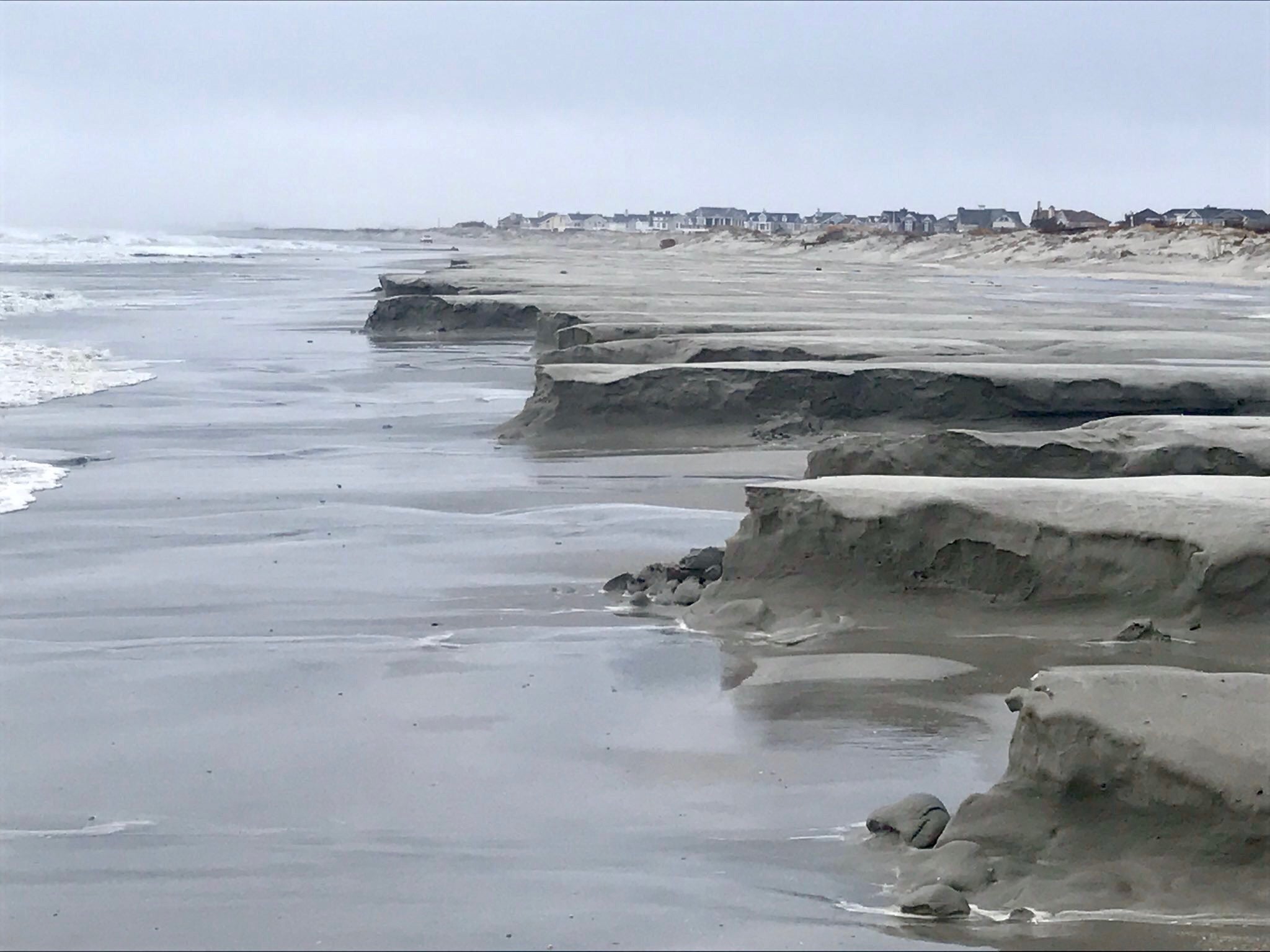Wind and tides, not snowfall, the big problems on the Jersey Shore

Beach erosion this morning at Nuns' Beach in Stone Harbor. (Photo courtesy of Zeke Orzech)
The real story during today’s nor’easter at the Jersey Shore wasn’t snow.
Most Shore counties didn’t see much of any, nor was a clobbering ever in the cards. For most of Ocean County and Atlantic and Cape May counties, snow wasn’t the major concern in the forecast, unlike in North Jersey.
Rather, the morning from the Raritan to Delaware bayshores was spent dealing with high winds, heavy rain, tidal flooding, and beach erosion. It was a 180 degree change from yesterday.
@JSHurricaneNews today vs yesterday – from exact spot 24 hours difference at DelawareBay North #CapeMaypic.twitter.com/Of77ZUxhaX
— Ginny Murray (@gin_murray) March 14, 2017
Some areas, like Seaside Park in Ocean County and areas to the south, saw more than three inches of rain. Nearby Seaside Heights registered a 62 mile per hour mid-morning wind gust. Numerous locations at the Shore, including Tuckerton and Harvey Cedars, saw wind gusts in excess of 50 miles per hour.
SEASIDE PARK NJ wind gust to 60 MPH Rain total 3.37” @JSHurricaneNews
— Dominick Solazzo (@DominickSolazzo) March 14, 2017
Thousands in Ocean and Monmouth counties were without power for a time, with the majority seeing electric service return by the early afternoon hours.
Many of the areas that typically see tidal innundation during coastal storms were wet this morning. Heavy rain complicated flooding, which the National Weather Service says rose to widespread minor levels.
But moderate flooding was reported in spots from Atlantic City to Sandy Hook. One storm gague in Atlantic City approached the major flooding stage before quickly falling.
Sea Bright in Monmouth County, a low-lying area that typically sees flooding from the Shrewsbury River, experienced flooding at moderate levels. No significant property damage was reported.
Shrewsbury river coming over banks in #seabright – we’re seeing flooding near our hotel, taking chairs, tables. Docks submerged @PIX11Newspic.twitter.com/IU3G6CUHmU
— Christie Duffy (@ChristieDuffy) March 14, 2017
Also in Monmouth County, Route 35 was closed in a portion of low-lying Belmar for a time, a typical requirement during storm events.
In Atlantic County’s Ventnor, some were reportedly rescued from cars that had stalled in floodwaters.
Waters rescues are underway due to flooding in numerous locations. Please stay off the roads until high tides recede around noon!! pic.twitter.com/A8gGflmyuz
— Ventnor 411 (@Ventnor411) March 14, 2017
Further south in Cape May County, police in West Wildwood, which suffered major flooding during a January 2016 storm, say the tide was “high minor,” with most streets passable and no “exceptional” problems.
But forecasters say the quick movement of the storm, coupled with shifting winds from the northeast to northwest, would limit tidal flooding to the morning high tide.
Along the oceanfront, no serious breaches were reported, but beaches took a beating.
In highly vulnerable Ortley Beach, the Ocean County community that was decimated by Superstorm Sandy in 2012 and where beach replenishment is slated to begin this spring, high waves eroded most of the beach. But temporary berms mostly held their ground.
Ortley Beach , 8th Ave. , Nor’easter #Ortley#Stella@JSHurricaneNewspic.twitter.com/oa2OvMG3K5
— AR Willis (@Willisrose1719) March 14, 2017
Down in Cape May County’s Stone Harbor, where 394,000 cubic yards of sand were recently pumped onto the beach as part of a replenishment project, local resident Zeke Orzech reported significant erosion.
A photo and video by Orzech showed large chucks of sand eroded and washed into the ocean at “Nuns’ Beach” on 110th Street.
#StoneHarborNJ newly replenished beaches to a hit from #Stella This is at nuns beach 110st. pic.twitter.com/APPY99hJND
— Zeke Orzech (@Zeke_O) March 14, 2017
Army Corps of Engineers spokesman Steve Rochette says significant erosion can happen after a beachfill.
“After the storm passes, our team and the state typically assess the level of erosion to projects and determine the best path forward,” he said in an email.
As the nor’easter pulls away this afternoon, the lasting reminder will be a freeze tonight of any standing water and slush.
Forecast low temperatures for tonight. Anything wet turns icy, anything slushy turns solid. pic.twitter.com/G5bjdBqIn2
— Gary Szatkowski (@GarySzatkowski) March 14, 2017
WHYY is your source for fact-based, in-depth journalism and information. As a nonprofit organization, we rely on financial support from readers like you. Please give today.

